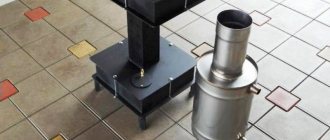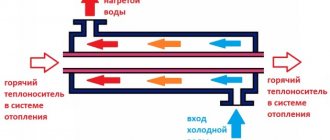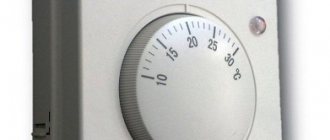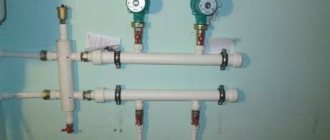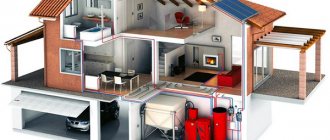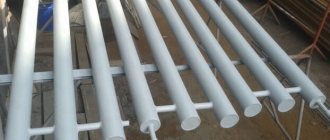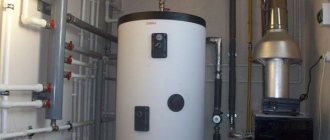Self-manufacturing of a heat accumulator is possible for every person who has the skills to work with basic plumbing and household tools. To assemble such a unit you will not have to buy any expensive parts and materials. Components for the simplest model can be found in the garage or pantry of any thrifty and economical person.
Thermal accumulator
After studying the following guide, you will be able to make your own heat accumulator and connect it to the heating system.
What is a heat accumulator?
A heat accumulator is a buffer reservoir designed to accumulate excess heat volumes generated during boiler operation. The saved resource is then used in the heating system in the period between scheduled loads of the main fuel resource.
Connecting a properly selected battery allows you to reduce the cost of purchasing fuel (in some cases up to 50%) and makes it possible to switch to one load per day instead of two.
In addition to the function of accumulating the generated heat, the buffer tank protects cast iron units from cracking in the event of an unexpected and sharp change in the temperature of the operating network water
If you equip the equipment with intelligent regulators and temperature sensors, and automate the heat supply from the storage tank to the heating system, heat transfer will increase significantly, and the number of portions of fuel loaded into the combustion chamber of the heating unit will noticeably decrease.
Features of internal and external devices
The heat accumulator is a vertical cylinder-shaped tank made of high-strength black or stainless steel sheet.
There is a layer of bakelite varnish on the inner surface of the device. It protects the buffer tank from the aggressive influence of industrial hot water, weak salt solutions and concentrated acids. Powder paint is applied to the outside of the unit, resistant to high thermal loads.
The tank volume varies from 100 to several thousand liters. The most capacious models have large linear dimensions, making it difficult to place equipment in the limited space of a home boiler room
External thermal insulation is made of recycled polyurethane foam. The thickness of the protective layer is about 10 cm. The material has a specific complex weave and an internal polyvinyl chloride coating.
This configuration prevents particles of dirt and small debris from accumulating between the fibers, provides a high level of water resistance and increases the overall wear resistance of the heat insulator.
The heat insulator is not always included in the heat accumulator kit. Sometimes you have to buy it separately and then install it on the unit yourself
The surface of the protective layer is covered with a cover made of good quality leatherette. Thanks to these conditions, the water in the buffer tank cools much more slowly, and the level of overall heat loss of the entire system is significantly reduced.
Insulation
The better the tank is insulated, the less fuel is required to heat the entire volume of water, and the longer the coolant will maintain a high temperature.
You may come across advice to insulate rectangular tanks with sheets of polystyrene foam - it is affordable, not afraid of moisture, and can be easily glued to a flat surface with a heat-resistant compound. However, this is not the best option, since the steel walls of the container become very hot, and polystyrene foam releases harmful substances when heated.
A reliable option for insulating a heat accumulator is basalt wool
It is better to perform insulation with rolled material made of basalt wool, intended for thermal insulation of chimneys. If you decide to use conventional insulation made of mineral or stone wool, you must ensure that it does not contain phenol-formaldehyde resins, which also release substances hazardous to health when exposed to high temperatures.
Note! The recommended density of mineral wool thermal insulator is 135-145 kg/m3.
The protective casing is made of thin sheet metal. It simultaneously protects the heat insulator from moisture and external influences, and serves as a reflector for thermal radiation passing through the insulating layer.
The operating principle of a heat-saving product
The heat accumulator operates according to the simplest scheme. A pipe from a gas, solid fuel or electric boiler is connected to the unit from above.
Hot water flows through it into the storage tank. Cooling down during the process, it falls down to the location of the circular pump and, with its help, is fed back into the main passage to return to the boiler for the next heating.
Installing a heat accumulator prevents overheating of the coolant when the boiler is operating at full power and ensures maximum heat transfer with economical fuel consumption. This reduces the load on the heating system and extends its service life
A boiler of any type, regardless of the type of fuel resource, operates in steps, periodically turning on and off when the optimal temperature of the heating element is reached.
When work stops, the coolant enters the reservoir, and in the system it is replaced by hot liquid that has not cooled due to the presence of a heat accumulator. As a result, even after the boiler is turned off and goes into passive mode until the next fuel supply, the batteries remain hot for some time, and warm water comes out of the tap.
With bottom or top position
There are three options for connecting a storage tank and using the water supply:
- Top location of the container. In this case, water is drawn under the influence of gravity. The higher the accumulator is located in relation to the consumer, the stronger the water pressure. Every 10 meters of height adds 0.1 atmosphere, or approximately 1 bar.
- Bottom location of a simple storage tank. Gravity will no longer help, and a pump is used to supply it to the water supply system, raising the pressure to the optimal level.
- Membrane-type storage tanks themselves create the required pressure for water supply. A lower location at the consumer level is optimal for them, since there will be no advantage from installing in an attic or tower.
How to determine the best option?
If a house has several floors and it is possible to place a storage tank in the attic, then this will eliminate the need for additional installation of a pump, and there is no need to spend money on an expensive membrane tank. In fact, this is an analogue of a water tower. However, raise the container so high as to ensure a comfortable pressure of 2-2.5 atm. it's still difficult. Moreover, the question arises of insulating the tank so that the water in it does not freeze in winter.
In the event of an emergency shutdown of water, the existing pressure is 0.2-0.3 atm. It will be quite enough to use the faucet in the sink, toilet or even shower, but it will not be possible to use some household appliances, such as a washing machine or dishwasher, which require more pressure to operate the solenoid valves.
Installing the tank at the same level as the consumer is suitable in cases where it is not possible to raise the tank to the attic or at least to a higher floor. The same applies to installing a storage tank in an apartment. You will need a small pump to supply water under pressure to the water supply. To ensure adequate operation, the pump will require a diaphragm expansion tank.
A storage tank with a membrane is perfect for storing water reserves both when using a centralized water supply system and in an autonomous system. However, it does not require additional equipment or overhead location. However, its cost is significantly higher than any conventional storage tank, even in combination with a simple pump.
Types of heat storage models
All buffer tanks perform almost the same function, but have some design features.
Manufacturers produce three types of storage units:
- hollow (without internal heat exchangers);
- with one or two coils , ensuring more efficient operation of the equipment;
- with built-in boiler tanks of small diameter, designed for the correct operation of an individual hot water supply complex for a private home.
The heat accumulator is connected to the heating boiler and the communication wiring of the home heating system through threaded holes located in the outer casing of the unit.
How does a hollow unit work?
The device, which has neither a coil nor a built-in boiler inside, is one of the simplest types of equipment and costs less than its more “sophisticated” counterparts.
It is connected to one or more (depending on the needs of the owners) energy sources through central communications, and then through 1 ½ pipes it is routed to points of consumption.
It is planned to install an additional heating element operating on electrical energy. The unit provides high-quality heating of residential property, minimizes the risk of coolant overheating and makes operation of the system completely safe for the consumer.
When a residential building already has a separate hot water supply system and the owners do not plan to use solar thermal heat sources to heat the room, it is advisable to save money and install a hollow buffer tank in which the entire usable area of the tank is given over to the coolant and is not occupied by coils
Thermal accumulator with one or two coils
A heat accumulator equipped with one or two heat exchangers (coils) is a progressive option for equipment with a wide range of applications. The upper coil in the design is responsible for the selection of thermal energy, and the lower one carries out intensive heating of the buffer tank itself.
A device equipped with heat exchangers has a higher price than a hollow unit, but the costs here are completely justified. The device significantly expands the functionality of the system and makes its operation much more efficient.
The presence of heat exchange units in the unit allows you to receive hot water for domestic needs around the clock, heat the tank from the solar collector, warm up house paths and make the most efficient use of useful heat for any other convenient purposes.
Module with internal boiler
A heat accumulator with a built-in boiler is a progressive unit that not only accumulates excess heat generated by the boiler, but also ensures the supply of hot water to the tap for domestic purposes.
The internal boiler tank is made of stainless alloy steel and equipped with a magnesium anode. It reduces the level of water hardness and prevents the formation of scale on the walls.
Owners choose the appropriate volume of the buffer tank on their own, but experts say that there is no practical point in purchasing a tank less than 150 liters
A unit of this type connects to various energy sources and works correctly with both open and closed systems. Controls the temperature level of the operating coolant and protects the heating complex from overheating of the boiler.
Optimizes fuel consumption and reduces the number and frequency of loading. Compatible with solar collectors of any model and can function as a substitute for a hydraulic boom.
To summarize: What are the advantages and disadvantages of using buffer tanks?
The obvious “advantages” of autonomous solid fuel heating systems with a heat accumulator include the following:
- The energy potential of solid fuel is used to the maximum extent possible. Accordingly, the efficiency of boiler equipment increases sharply.
- The operation of the system will require much less human intervention - from reducing the number of boiler loadings with fuel to expanding the ability to automate the control of operating modes of various heating circuits.
- The solid fuel boiler itself receives reliable protection against overheating.
- The operation of the system becomes smoother and more predictable, providing a differentiated approach to heating different rooms.
- There are ample opportunities to modernize the system, including the launch of additional sources of thermal energy, without dismantling the old ones.
- In most cases, the problem of hot water supply at home is also solved.
The disadvantages are very peculiar, and you also need to have an idea about them:
- A heating system equipped with a buffer tank is characterized by very high inertia. This means that from the moment of initial ignition of the boiler until reaching the nominal operating mode it will take quite a lot of time. This is unlikely to be justified in a country house, which in winter the owners visit only on weekends - in such situations, rapid heating is required.
- Heat accumulators are bulky and heavy (especially when filled with water) structures. They require enough space and a well-prepared, reliable foundation. Moreover, it is close to the heating boiler. This is not possible in every boiler room. Plus, there are difficulties with delivery and unloading, and often also with bringing the container into the room (it may not fit through the door). All this should be taken into account in advance.
- The disadvantages include the very high price of such devices, which sometimes even exceeds the cost of the boiler. This “minus”, however, brightens up the expected saving effect from more rational use of fuel.
- The heat accumulator will fully reveal its positive qualities only if the rated power of the solid fuel boiler (or the total power of other heat sources) is at least twice as high as the calculated value required for effective heating of the house. Otherwise, purchasing a buffer capacity seems unprofitable.
Date: September 25, 2022
Scope of application of the heat accumulator
The heat accumulator collects and stores the energy generated by the heating system, and then helps to use it as rationally as possible for efficient heating and providing residential premises with hot water.
You need to purchase a device for accumulating excess heating resources only in specialized stores. The seller must provide the buyer with a product quality certificate and complete instructions for use
It works with different types of equipment, but is most often used in conjunction with solar collectors, solid fuel and electric boilers.
Thermal accumulator in a solar system
A solar collector is a modern type of equipment that allows you to use free solar energy for everyday household needs. But without a heat accumulator, the equipment is not able to fully function, since solar energy is supplied unevenly. This is due to changes in time of day, weather conditions and seasonality.
A solar collector equipped with a heat accumulator is placed on the south side of the site. There the device absorbs maximum energy and gives effective output
If the heating and water supply system is powered only by a single energy source (the sun), at some points residents may have serious problems with the supply of resources and obtaining the usual elements of comfort.
A heat accumulator will help you avoid these unpleasant moments and make the most efficient use of clear, sunny days to accumulate energy. To operate in a solar system, it uses the high heat capacity of water, 1 liter of which, cooling by just one degree, releases thermal potential to heat 1 cubic meter of air by 4 degrees.
The solar collector and heat accumulator form a single system, making it possible to use solar energy as the only source for heating a residential building
During the period of peak solar activity, when the solar collector collects the maximum amount of light and energy production significantly exceeds consumption, the heat accumulator accumulates the excess and supplies it to the heating system when the supply of resource from the outside decreases or even stops, for example, at night.
The following article will introduce you to options and schemes for alternative heating for country property, which we recommend reading.
Buffer tank for solid fuel boiler
Cyclicity is a characteristic feature of the operation of a solid fuel boiler. At the first stage, firewood is loaded into the firebox and heating occurs for some time. Maximum power and the highest temperatures are observed at the peak of the bookmark combustion.
Then the heat transfer gradually decreases, and when the wood finally burns out, the process of generating useful heating energy stops. All boilers operate on this principle, including long-burning appliances.
It is not possible to precisely configure the unit to generate thermal energy in relation to the level of consumption required at any given moment. This function is only available in more advanced equipment, for example, in modern gas or electric heating boilers.
Therefore, immediately at the moment of ignition and when reaching actual power, and then during the process of cooling and the forced passive state of the equipment, there may simply not be enough thermal energy for full heating and heating of hot water.
But during peak operation and the active phase of fuel combustion, the amount of energy released will be excessive and most of it will literally “fly down the drain.” As a result, the resource will be spent irrationally, and the owners will have to constantly load new portions of fuel into the boiler.
In order for the house to be heated for a long time after the solid fuel boiler is turned off, you need to purchase a large buffer tank. It will not be possible to accumulate a significant amount of resource in a small reservoir and its purchase will be a pointless waste of money
This problem is solved by installing a heat accumulator, which will accumulate heat in the tank at times of increased activity. Then, when the wood burns out and the boiler goes into passive standby mode, the buffer will transfer the collected energy to the coolant, which will warm up and begin to circulate through the system, heating the room bypassing the cooled appliance.
Reservoir for electrical system
Electric heating equipment is a rather expensive option, but it is sometimes installed, and, as a rule, in conjunction with a solid fuel boiler.
Typically, the electric type of heating is installed where other sources of heat are not available due to objective reasons. Of course, with this heating method, electricity bills increase significantly and home comfort costs owners a lot of money.
The buffer tank must be installed directly next to the heating boiler. The equipment has substantial dimensions and in a private house you will have to allocate a special room for it. The system will fully pay for itself within 2-5 years
In order to reduce electricity costs, it is advisable to use the equipment to the maximum during the preferential tariff period, that is, at night and on weekends.
But such an operating mode is possible only if there is a capacious buffer tank, where the energy generated during the grace period will accumulate, which can then be spent on heating and supplying hot water to residential premises.
Manufacturing stages
When considering how to make a heat accumulator yourself, you need to pay attention to the requirements for the container - it must be strong enough to withstand the operating pressure in the system, this parameter is usually 3 atmospheres. If a used metal barrel is used as a reservoir, its internal surface should be thoroughly cleaned from traces of corrosion.
If a used metal barrel is used as a reservoir, its internal surface should be thoroughly cleaned from traces of corrosion.
Before making a thermal energy storage device, decide how it will be used in the circuit. Typically, a thermal accumulator is installed as a hydraulic separator. In this case, four fittings cut into it. For ease of connection, the length of the fittings should be greater than the thickness of the insulation.
TA with embedded fittings
A pair of fittings are cut into the upper and lower parts on the side of the boiler, the second pair - symmetrically on the opposite side, the heating circuit will be connected to them. Tees with thermometers are connected to the pipes installed in the lower part of the container.
The container with installed fittings should be wrapped in foil, creating a reflective layer. A thermal insulator is attached on top. The rolled material can be secured with wire, tightening the loops by twisting the free ends.
It is advisable to cover the completed thermal insulation layer with a casing, for the manufacture of which thin sheet metal is suitable.
Conclusion
Even the simplest heat accumulator for heating boilers can significantly improve a heating system with a solid fuel boiler. Its installation makes it possible to maintain a comfortable temperature level in the house for several hours by extinguishing the fire in the boiler. You have to heat your house less often, which reduces energy costs.
Do-it-yourself energy storage device
The simplest possible model of a heat accumulator can be made with your own hands from a ready-made steel barrel. If you don’t have one at your disposal, you will have to purchase several sheets of stainless steel with a thickness of at least 2 mm and weld them into a container of a suitable size in the form of a vertical cylindrical tank.
It is not recommended to use a Eurocube to make a heat accumulator. It is designed for contact with coolant having an operating temperature of up to + 70 ºС and simply will not withstand hotter liquids
DIY Guide
To heat the water in the buffer, you will need to take a copper tube with a diameter of 2-3 centimeters and a length of 8 to 15 m (depending on the size of the tank). It will have to be bent into a spiral and placed inside the tank.
The battery in this model will be the top of the barrel. From there you need to remove the outlet pipe for the hot water outlet, and make the same one from below for the cold water inlet. Each outlet should be equipped with a tap to control the flow of liquid into the accumulation zone.
In an open heating system, a rectangular steel tank can be used as a buffer tank. In a closed system this is excluded due to possible surges in internal pressure
The next step is to check the container for leaks by filling it with water or lubricating the welds with kerosene. If there is no leak, you can proceed to creating an insulating layer that will allow the liquid inside the tank to remain hot for as long as possible.
How to insulate a homemade unit?
To begin with, the outer surface of the container must be thoroughly cleaned and degreased, and then primed and painted with heat-resistant powder paint, thus protecting it from corrosion.
Then wrap the tank with glass wool insulation or rolled basalt wool 6-8 mm thick and secure it with cords or regular tape. If desired, cover the surface with sheet metal or “wrap” the tank in foil film.
You should not use extruded polystyrene foam or polystyrene foam for insulation. With the onset of cold weather, these materials may harbor mice looking for a warm place to live during the winter.
Holes for outlet pipes should be cut in the outer layer and the container should be connected to the boiler and heating system.
The buffer tank must be equipped with a thermometer, internal pressure sensors and an explosion valve. These elements allow you to control potential overheating of the barrel and relieve excess pressure from time to time.
General connection rules
A water tank is installed on a prepared site: a concrete base tied to the foundation, or a reinforced metal frame made of profiled pipe. The design must withstand one and a half weight of the tank and the water in it when completely filled.
The inlet pipe can be of any suitable diameter, water is supplied under pressure. The outlet pipe and pipe to the water supply system are chosen with a diameter one and a half to two times larger than the cross-section of the main line. The optimal size is 32 mm.
Even the best quality insulation only slows down the decrease in temperature in the tank. To prevent water from freezing when installing the tank in an unheated attic or on the roof, you should use any suitable heating system for the pipes and the tank itself.
Accumulated resource consumption rate
It is impossible to accurately answer the question of how quickly the heat accumulated in the battery is consumed.
How long the heating system will operate using the resource collected in the buffer tank directly depends on such items as:
- actual volume of storage capacity;
- level of heat loss in the heated room;
- outside air temperature and current time of year;
- set values of temperature sensors;
- useful area of the house that needs to be heated and supplied with hot water.
Heating of a private house in a passive state of the heating system can be carried out from several hours to several days. At this time, the boiler will “rest” from the load and its working resource will last for a longer period of time.
TA installation location
It is worth thinking about installing a heat accumulator at the stage of designing a heating system.
Important! Since the boiler unit will have to heat not only the coolant and water for the hot water system, but also the water in a large-volume tank, the load on the boiler increases significantly. This means that you should purchase a solid fuel boiler, the power of which is approximately 1.5 times higher than the calculated one.
Solid fuel boilers are designed for installation in a specially designated room. When designing a boiler room, you should consider the place where the heat storage device will be installed. It must be freely accessible in order to connect the container to the pipeline.
If it is not possible to place a tank of the required volume in close proximity to the boiler, you can connect two or more small heat accumulators in series.
For a solid fuel boiler, it is necessary to provide a specially designated place - a boiler room
Rules for safe operation
Heat batteries made at home with your own hands are subject to special safety requirements:
- Hot tank elements must not come into contact with or otherwise come into contact with flammable or explosive materials or substances. Ignoring this point may cause a fire in individual objects and a fire in the boiler room.
- A closed heating system involves constant high pressure of coolant circulating inside. To ensure this point, the tank structure must be completely sealed. Additionally, its body can be reinforced with stiffening ribs, and the lid on the tank can be equipped with durable rubber gaskets that are resistant to intense operating loads and elevated temperatures.
- If the design contains an additional heating element, its contacts must be very carefully insulated, and the tank must be grounded. In this way, it will be possible to avoid electric shock and short circuit, which can damage the system.
If these rules are followed, the operation of a self-made heat accumulator will be completely safe and will not cause any problems or hassle for the owners.
